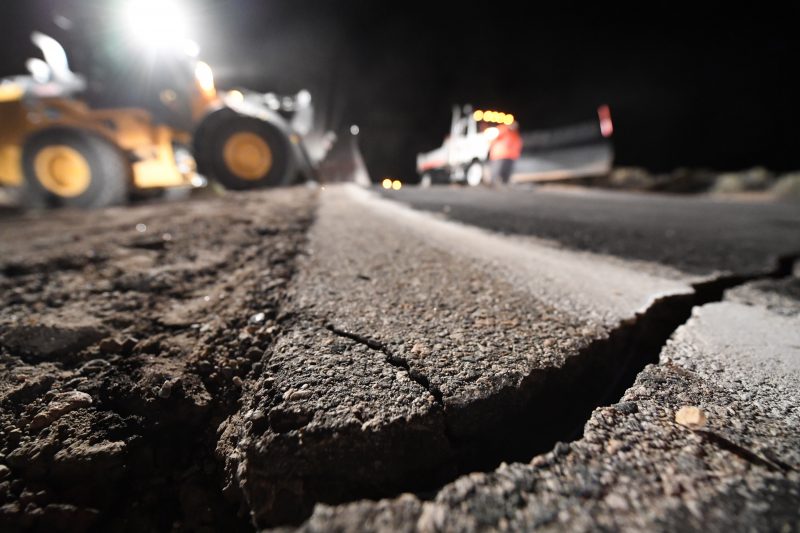Los Angeles ‘Big One’ quake fears revived by major shocks
While no major damage was reported to buildings in the region after the quake, the psychological toll on people living in fear of the “Big One” was evident (Robyn Beck)
Los Angeles (AFP) – Two strong earthquakes that pierced years of seismic calm in southern California have revived fears of the “Big One” striking Los Angeles, with officials warning citizens to be prepared for further shocks.
A 7.1-magnitude quake that struck a remote region some 150 miles (240 kilometers) northeast of Los Angeles on Friday evening was felt throughout the city, prompting Angelenos to evacuate homes, bars, restaurants and movie theaters.
The quake — which followed a 6.4-magnitude tremor the previous day — caused only minor damage in Los Angeles such as scattered power outages. It struck on a smaller faultline not directly linked to the major San Andreas fault.
But for many in the city, it served as a powerful reminder of the realities of living on an active tectonic zone.
“Yesterday I was in shock because I realized I didn’t know exactly what to do,” said Cristina Alhamad, 29, mother to a one-month-old baby.
“I heard my neighbors running, screaming in the halls and I just froze because some said to stay in, others to stay out.”
Alhamad said she had packed some essential items for her baby to place by the door after the first quake, but in the moment of Friday’s larger shock she “just took the baby and left.”
Andrea Briceno, a TV producer living in Los Angeles, told AFP she had participated in lots of drills and kept an “earthquake bag” with supplies of water and canned goods, but still found the quake scary.
“As far as a plan, I don’t really have one — just stay under the desk at the house where the backpack is,” she said.
“If it’s somewhere else, I wouldn’t really know what to do.”
– ‘Great reminder’ –
Politicians including presidential hopeful Senator Kamala Harris and Congresswoman Karen Bass were among those urging Californians to boost preparedness Saturday.
“This isn’t a drill. Make sure you and your family are ready for the big one,” said Bass on Twitter.
But prior to the first quake on Thursday, southern California had been in an “earthquake drought,” with nothing measuring above 6.0 magnitude since early 2010.
Following Friday’s event, Caltech seismologist Lucy Jones warned there is a 10 percent chance of another magnitude 7.0 or higher quake in the next week.
“People in southern California know that they live in earthquake country, but because they haven’t experienced strong shaking in many years they become complacent,” said John Bwarie, a Los Angeles-based community resilience expert.
The tremors were a “great reminder” to take action to prepare for the next major event, he said.
“This quake was further away from most Angelenos, they felt it but it wasn’t damaging — the next earthquake could be smaller but more damaging in their community.”
Los Angeles officials have long prioritized earthquake resilience, especially since the 1994 Northridge quake that killed 57 people.
The “Great ShakeOut” annual drill was launched in Southern California in 2008 to raise awareness and remind people of the right actions to take during an earthquake.
By last year, 50 million people around the globe participated in the event.
Sweeping “retrofit” ordinances introduced under Los Angeles Mayor Eric Garcetti have targeted more than 10,000 buildings for mandatory upgrades to make them safer in the event of a major quake.
– Shaken psyche –
But a 2008 survey found that, over a decade after the Northridge quake, fewer than half of Californian families had created an evacuation plan, and fewer than 20 percent had reinforced or inspected their homes, or purchased earthquake insurance.
And while the building retrofit is moving ahead, there are limits to what it can accomplish, experts warned.
“If you look at the inventory of buildings in southern California, the predominant number are not necessarily built to those modern codes,” said Ken O’Dell, president of the Structural Engineers Association of California.
For a concrete building “we could have significant collapse of a building built prior” to strict codes enacted in the 1970s, he said.
Even for buildings getting the retrofits, the changes are designed to prevent deaths — not necessarily ensure the house itself remains viable.
“We are moving as fast as we can within the understanding of our society and — I hate to say — a little bit of the economics,” O’Dell added.
And while no major damage was reported to buildings in the region after Friday’s quake, the psychological toll on people living in fear of the “Big One” was evident.
“People are going to shelters and sleeping outside, being less confident about their buildings,” said O’Dell.
“People are still very uncomfortable. It’s almost like our psyche has been shook more than our buildings.”
Disclaimer: Validity of the above story is for 7 Days from original date of publishing. Source: AFP.


